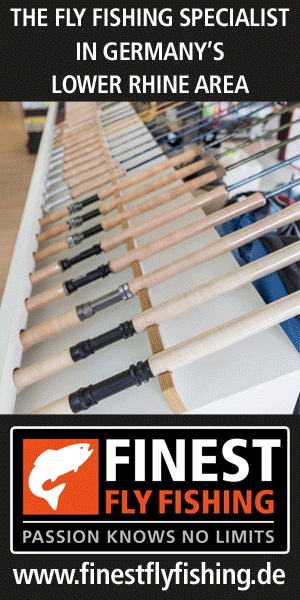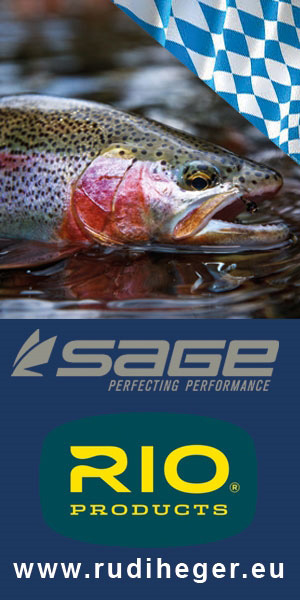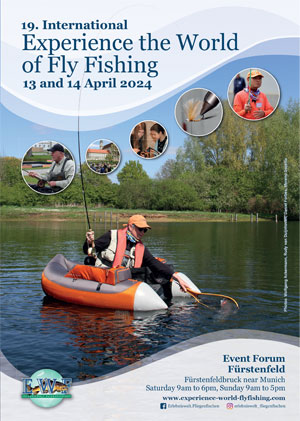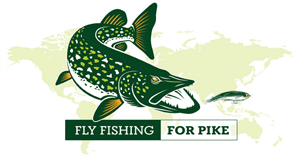
One does not need to cast all that far under normal fishing conditions. But if one is able to reach a nice distance under good circumstances, a good flycaster can, for example, also fish when there is a lot of wind. With the following text I hope to put readers on the way of becoming better flycasters.
Holding the rod correctly
A good way of casting starts by a proper grip on the rod. With rods in the range of #3 through #6, I prefer to put the forefinger on top of the handle, with the thumb lying next to it. This way of holding the rod has several advantages. The tendency to lower the rod too far on the backcast is reduced, while one will also put less force in the cast. Furthermore the precision will greatly improve this way, remember that when you are showing somebody the direction in which he or she has to go, you will do this with your forefinger, not your thumb…
Hold the rod not too tightly, this will only lead to an early tiredness of the hand and a spasmodic way of flycasting. In his book ‘Faszination Fliegenfischen’ Hans Ruedi Hebeisen described holding the rod as if one would be holding a live bird in the hand. And I have often demonstrated that it is easy to cast a nice length of line while only three fingers of the rodhand hold that flyrod. So there is no need to hold the rod firmly, completely white knuckles are the last thing I would want to see.

There is an easy way of telling when one is putting too much force in the rodhand, this is the case whenever you can hear the rod during the casting. The only thing one should hear is the line sliding through the rings, not the too sharp flick forward and backward. It is surpising to see how little effort is needed to lay out a nice length of line, nearly everyone uses too much force in the rodhand while casting.
Using superfluous power is always a drawback, except for some of the special trickcasts where we need a little extra power. When putting too much force in the rodhand the flyline will start to wave (this is caused by the extra downward movement of the rodtip), thus reducing the distance we can achieve. When not all the force has left the flyline and leader by the end of the cast, the fly will even fall back towards us. Once again: as long as we hear the rod while casting we are still using excessive power.
The basic cast
When taking the flyline of the water, we slowly speed up the rod’s movement. Close to the 12 o’clock position, if we think of a clock next to us, we accelerate the rod and make a sudden stop at the 1 o’clock position behind us. Only in this way will the flyline travel high into the air behind us. The more we lower the rod behind us for that stop, to the 2 o’clock position or even further, the sooner will our fly and line touch the ground behind us.
Not only can this be a costly affair, few flies can be tied as quickly as that we will loose them, we also greatly reduce the distance that we are able to reach. Whenever we make bad backcasts, we will never get the flyline out properly in front of us. At least as much emphasis has to be laid on the backcast as on the forward cast.

By the way, somewhat more energy has to be put into the backcast too. Should we put 50 % of our effort in the backcast and 50 % in the forward cast, than the result is that the backcast receives not enough energy. Should we aim to put something like 60 % in the backcast and the rest in the forwardcast, than the result will be that both casts are about equal.
The forwardcast needs an acceleration as well, we stop at about the 11 o’clock position and only after that should we lower the rodtip towards the surface of the water. When you speed up the line too late, the line and fly will hit the water with a big splash. Aim it too high and the result will be that the line and fly comes sailing back towards the flyfisher. It reaches it’s furthermost point high above the water and the wind will transport it back in your direction.
Waiting takes time
Whenever you make the sound of a whip with your line and the rats along the waterside sit on their backfeet thinking that they are in a circus, you don’t allow the flyline the time to roll out in the air. This will also cost you a great many flies, while trespassers think you whip the fish out of the water.

The longer the line you arealize, the more time it takes this flyline to travel the distance in front of and behind you. Only when the line has just about reached the distance it can go, should one start a new cast. Look back over your shoulder on the backcast so you can easily see when to start the forward cast. I always cast better when I follow the line the whole way, with my eyes.
Complete video’s have been made, with people who turn away their flyreel when they are casting their lines. This is also a castingfault, the reel should always point in the direction in which one is casting. Not only put rodmakers great efforts in placing the snake- and other guides on the right side of the rod, which we do not use when we turn the rod and reel, but also will the caster not be hit as often by his own flies. Because if we cast with the reel turned away to the side, the fly will travel backwards to the right of the rodtip, but might well come back along the other side (!). And that is where the caster is in most cases, bending on every forward cast is not too practical either, no matter how much we honour our opponent: the fish.
The reel should also stay close to the wrist in all stages of the cast, we use the wrist only to accelerate the speed of the line at the final moments of the forward- and backcast. This has to be a short movement, with the lower end of the rod only moving an inch orso away from and towards the wrist.
Casting while only using the wrist can only result in bad casting, keep it stiff and cast from your elbow. Or from your shoulder, in which case we come to the Gebetsroither-style of casting. This style has certain advantages over the English style of flycasting and I will come to this later.
Aiming high, ending low
When there are bushes behind a caster, one can often witness this person raising his arm on both forward- and backcast. Not only is this really tiring, we will need a cloth to lay our arm in by the end of the day, it badly influences the casting too. When raising arm and rod, the tip of the rod will perform part of a circle in the air, with the final section going down behind the caster. And when the tip makes a downward movement, the flyline will do the same! So keep your arm next to the body, there where it is most comfortable to cast. Casting in this way the tip of the rod will make an upward movement all the way through, as will line and fly. To make the flyline go even higher, stop the rod at the 12 o’clock position on the backcast instead of 1 o’clock. Only at the last stage of the backcast the rod may be raised somewhat, by raising the elbow a few inches, but only at that moment.

When there is no room at all behind us, due to high bushes or so, we will have to make use of the rollcast. This is the easiest cast of all to learn, but there are some points to remember here too. When we raise the rod and let the line come towards us – slowly – we have to wait until the line has passed our shoulder. Only than will the rod be properly loaded to make that flick forward. A great many people almost or completely hit the surface of the water on this forward movement. This means they make the acceleration to far down, beyond the 10 o’clock rodposition. The flyline will now travel on the watersurface, which costs more energy and disturbs more fish.
When the speeding up of the line is done close to the 11 o’clock position, the flyline will roll out above the water and land softly on it. Also when fishing a nymph, it will be pulled upward and out of the water, instead of pulled through the surface by which it greatly reduces the distance that could be achieved.
When our fly is floating to the left of us, we can not cast over our right shoulder to make it travel to the right. At this stage we have to make the rollcast with the line hanging close to our left shoulder. Otherwise the only result we get is a big tangle in the line.
When our fly is floating to the right of us we can normally cast, with line coming down close to the right shoulder, to make it travel to the left. Try this on the water and you will easily see what I mean. A sharp pull on the flyline, at the same moment as that we accelerate our rod, speeds up the line even further, which naturally leads to a possibly longer cast.






